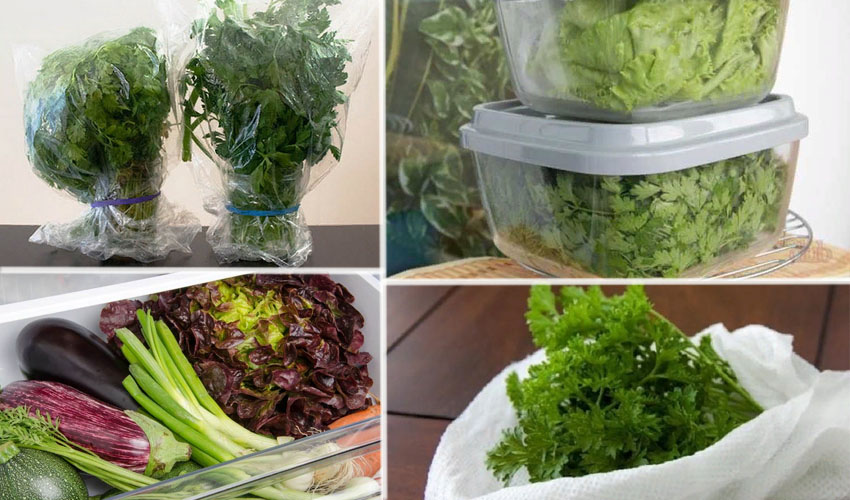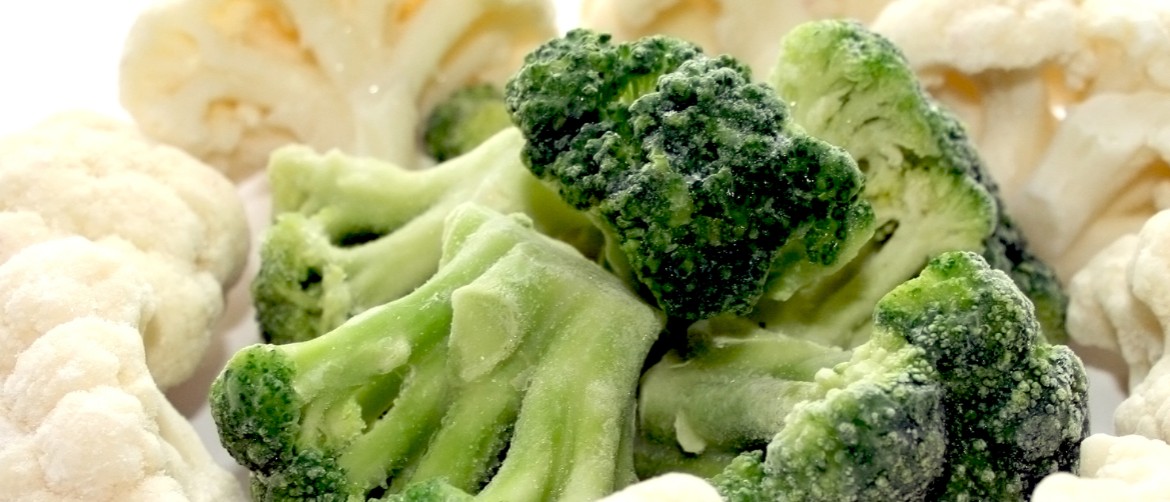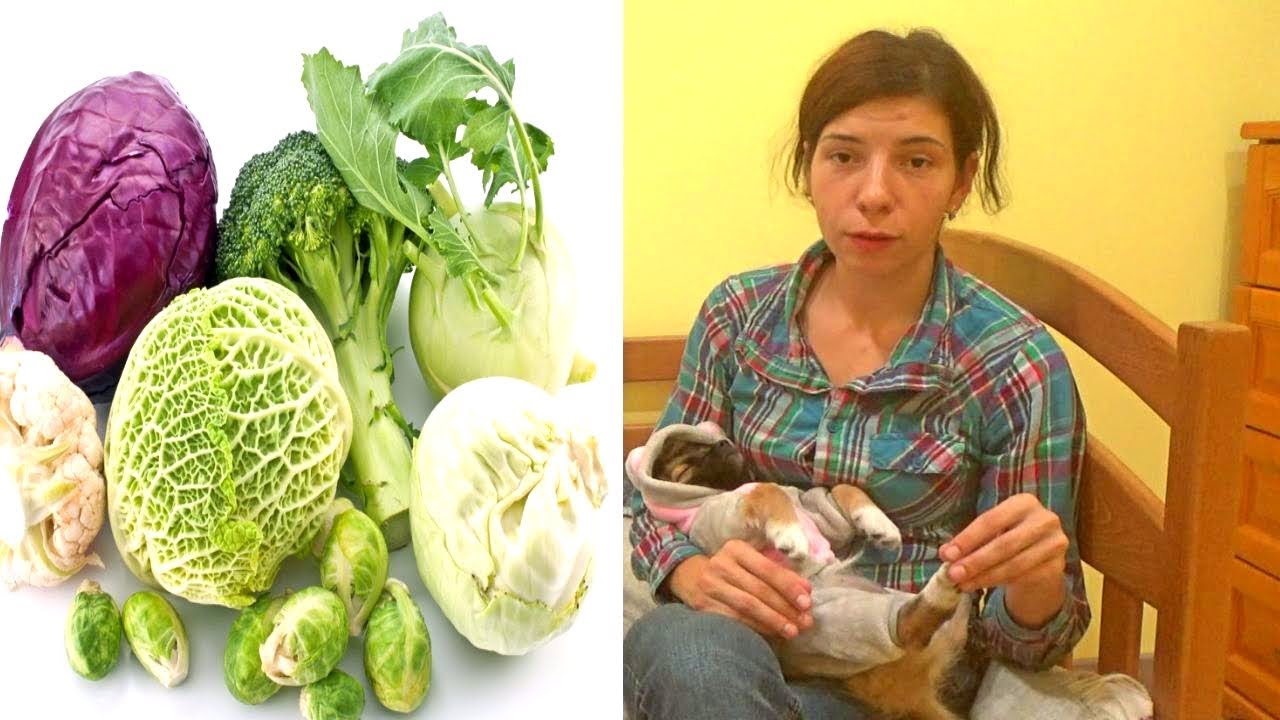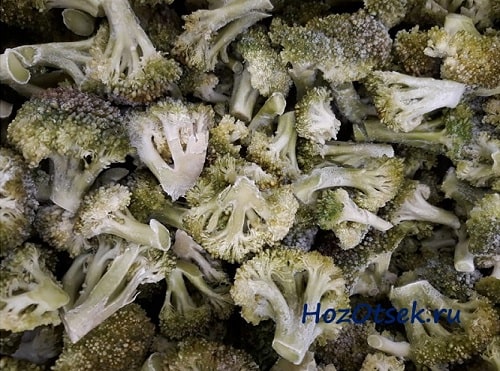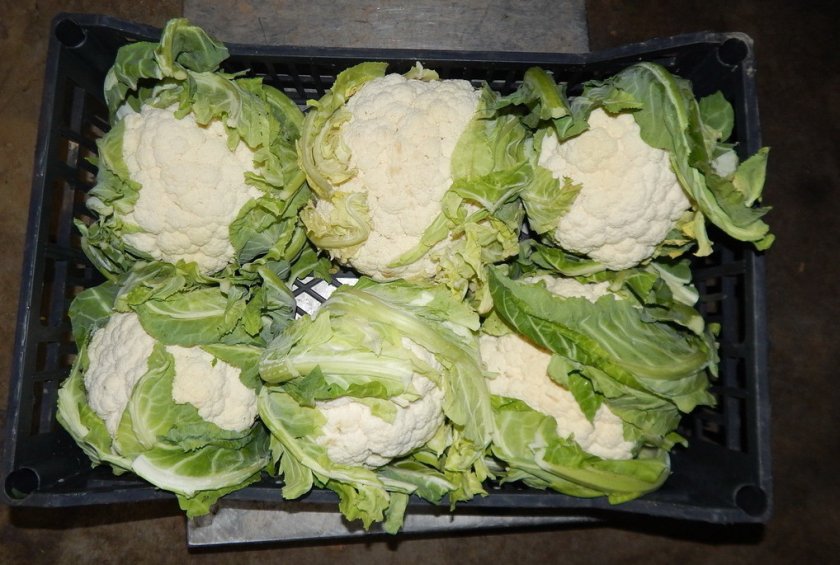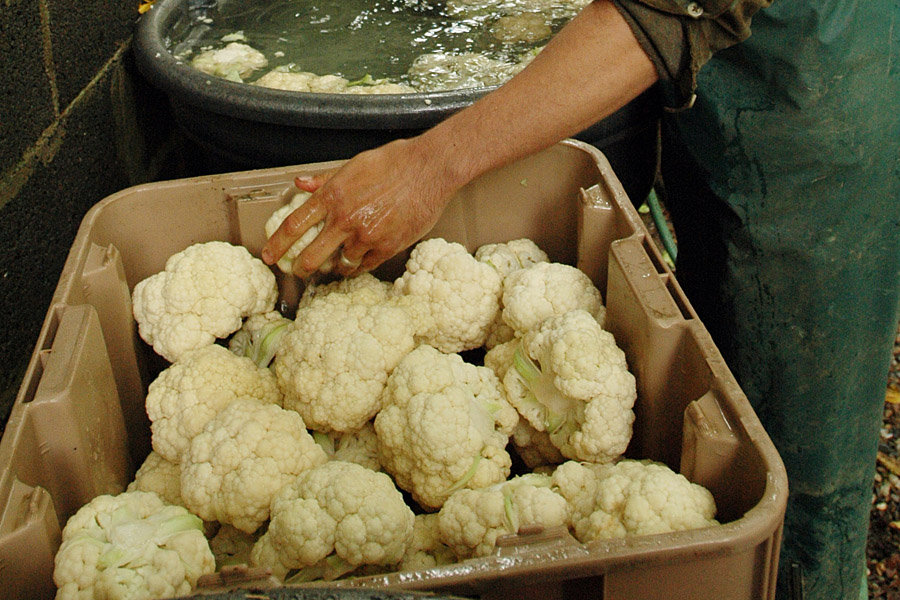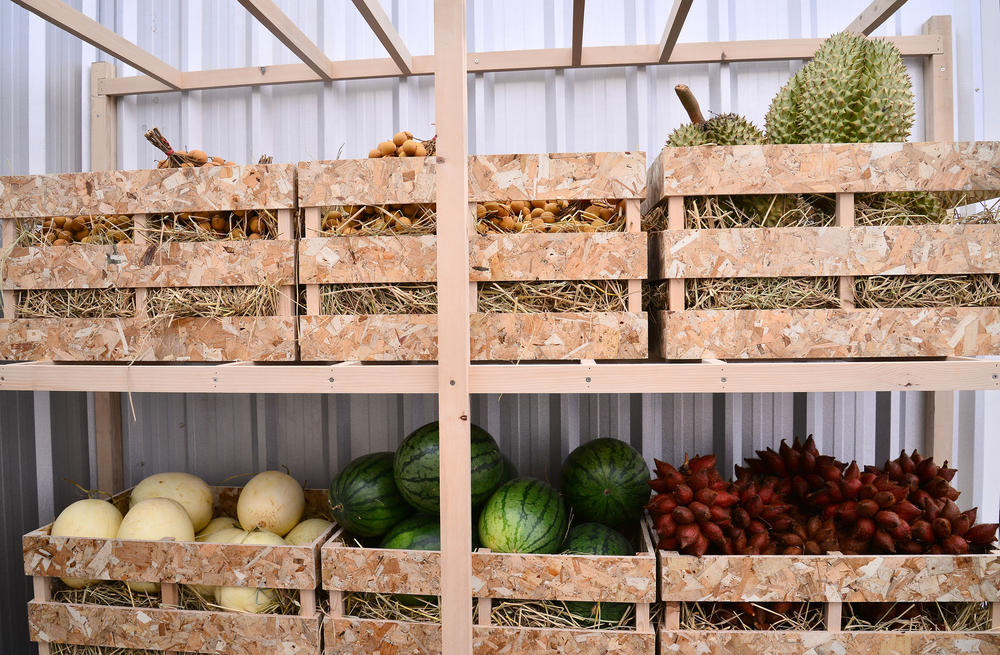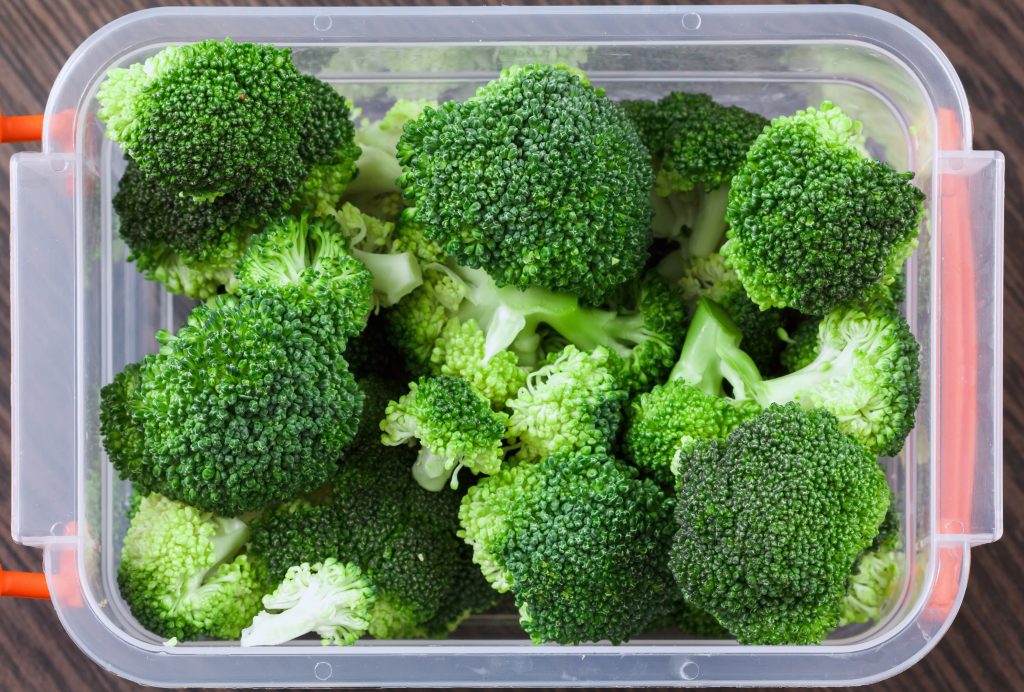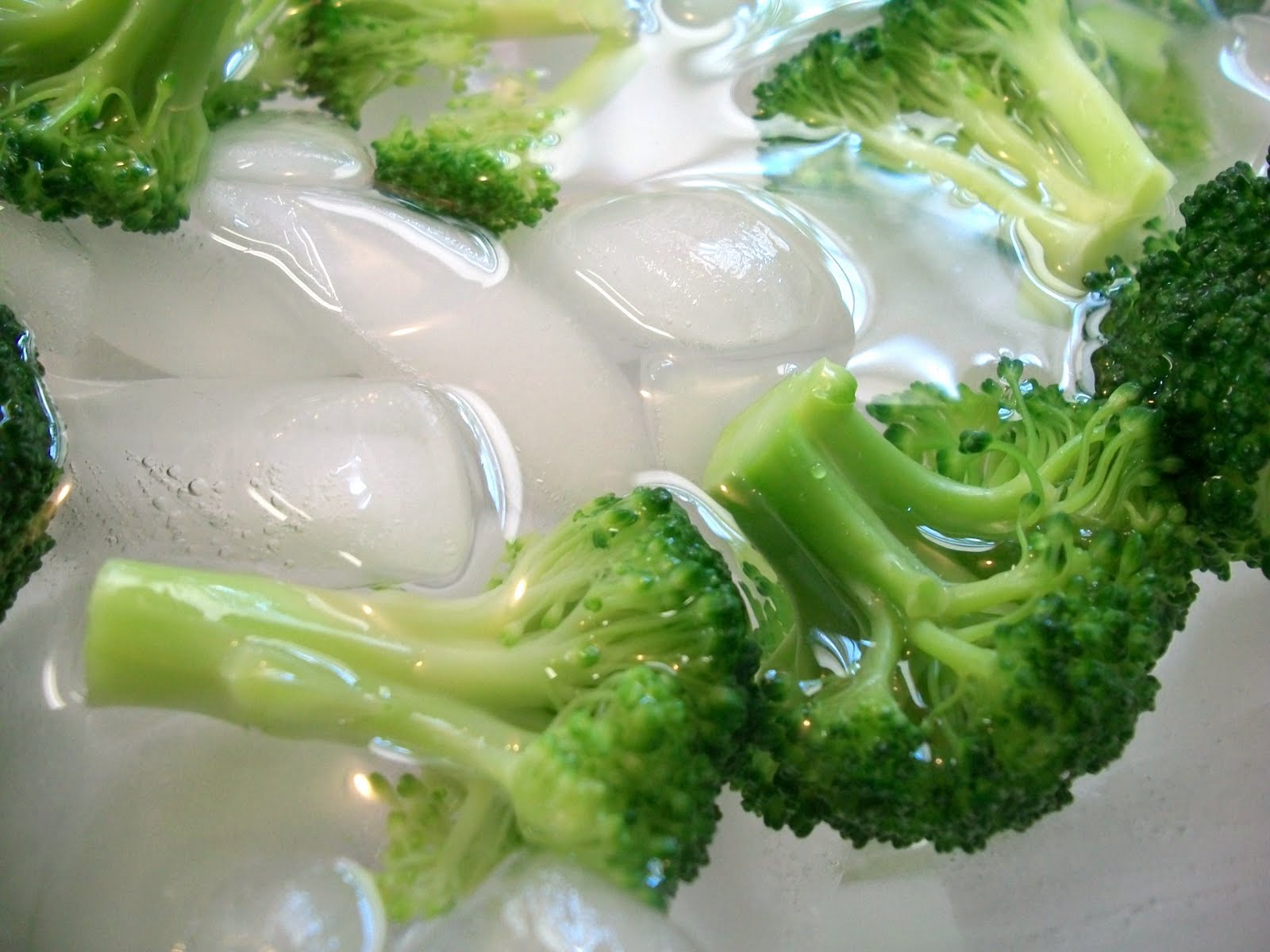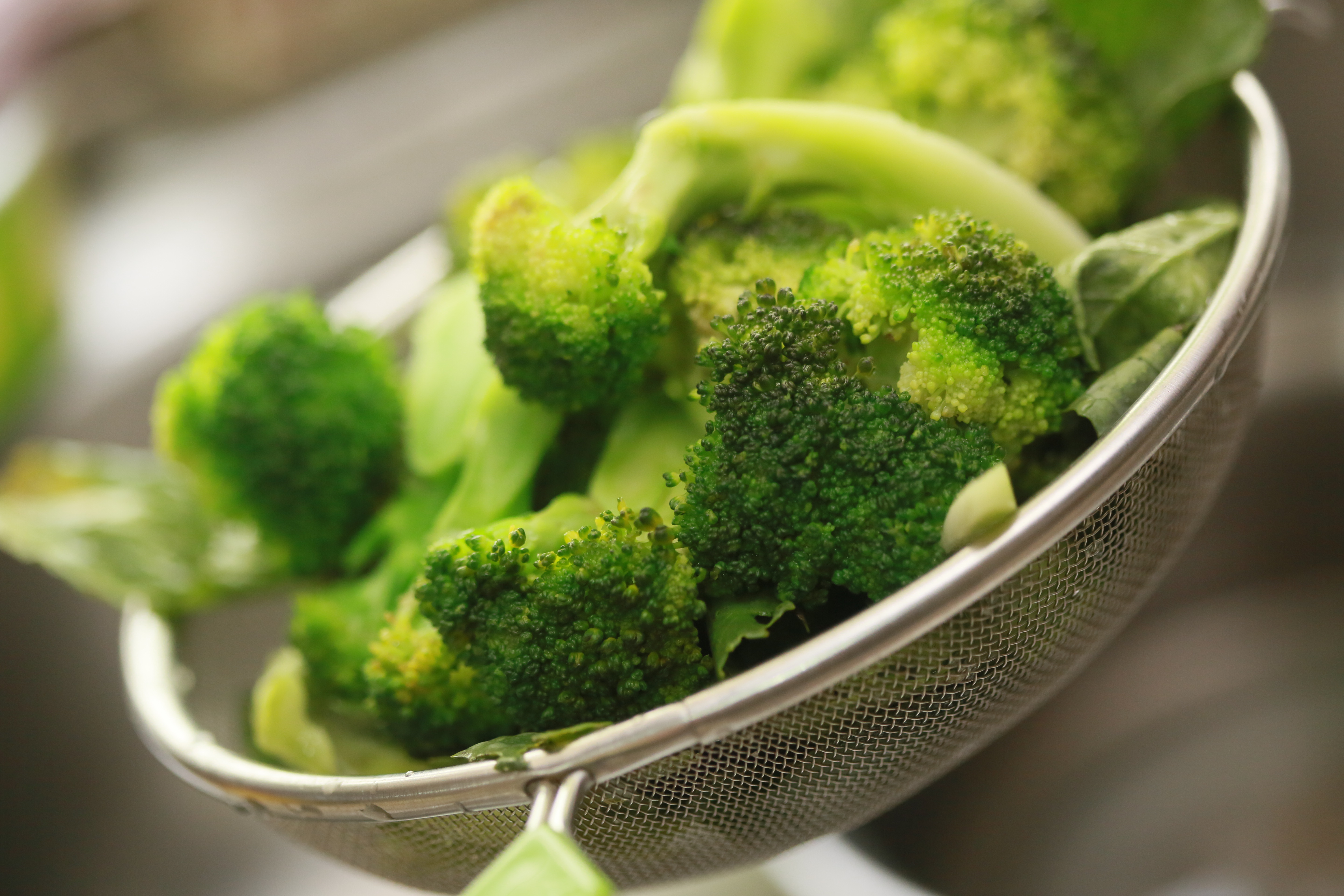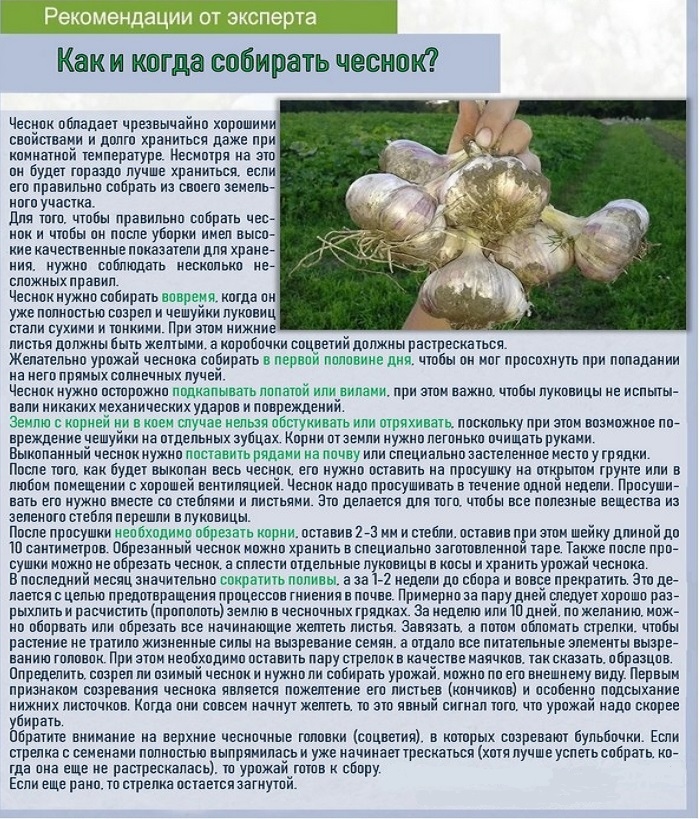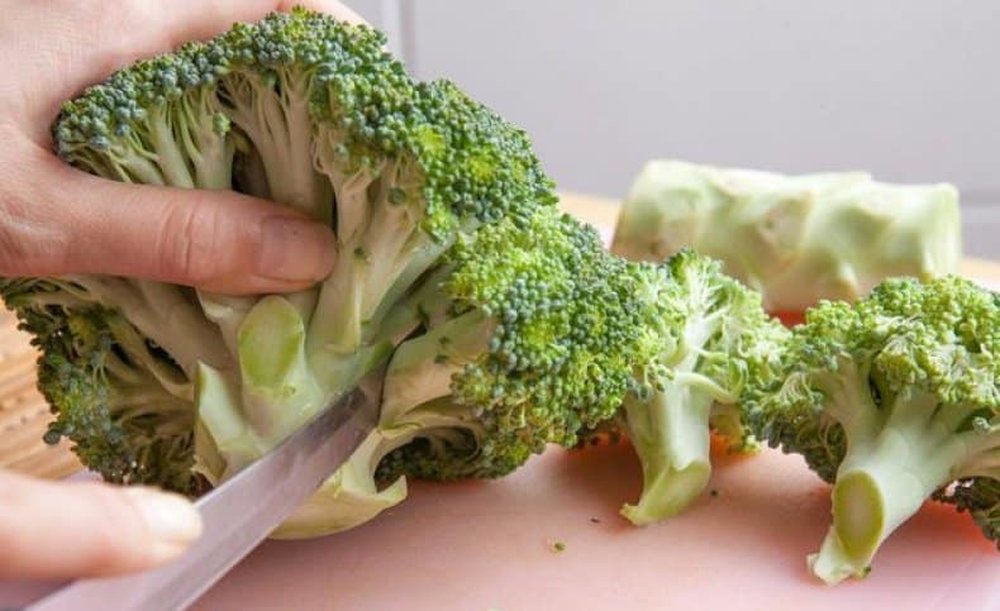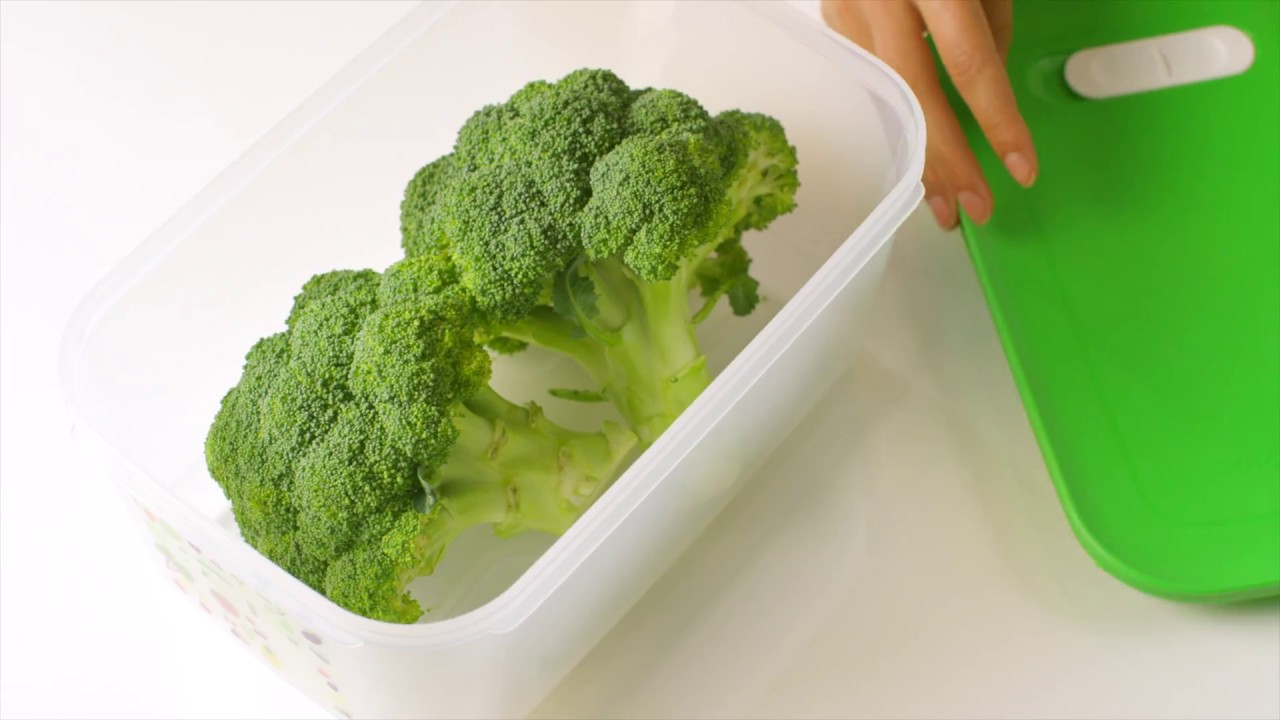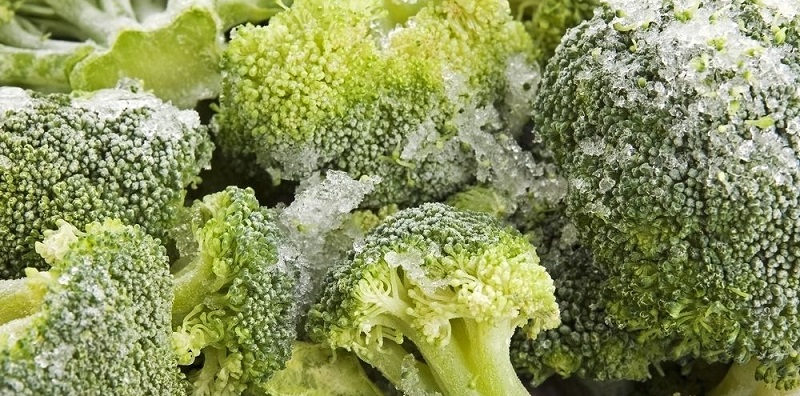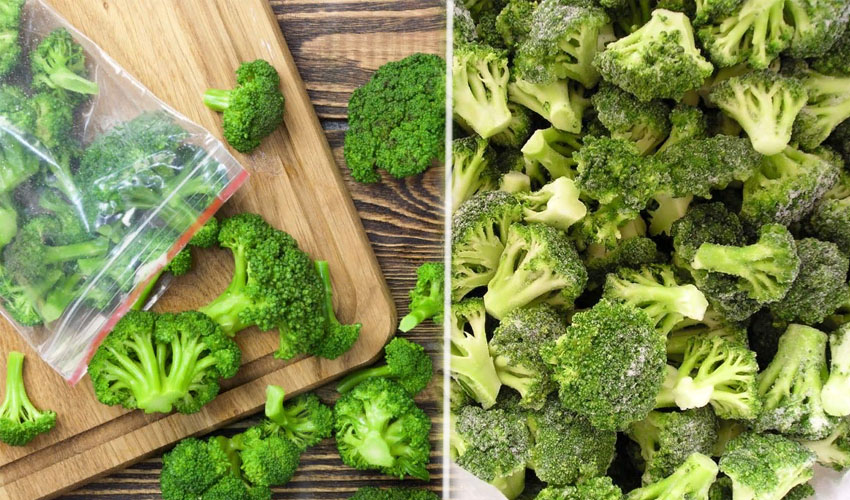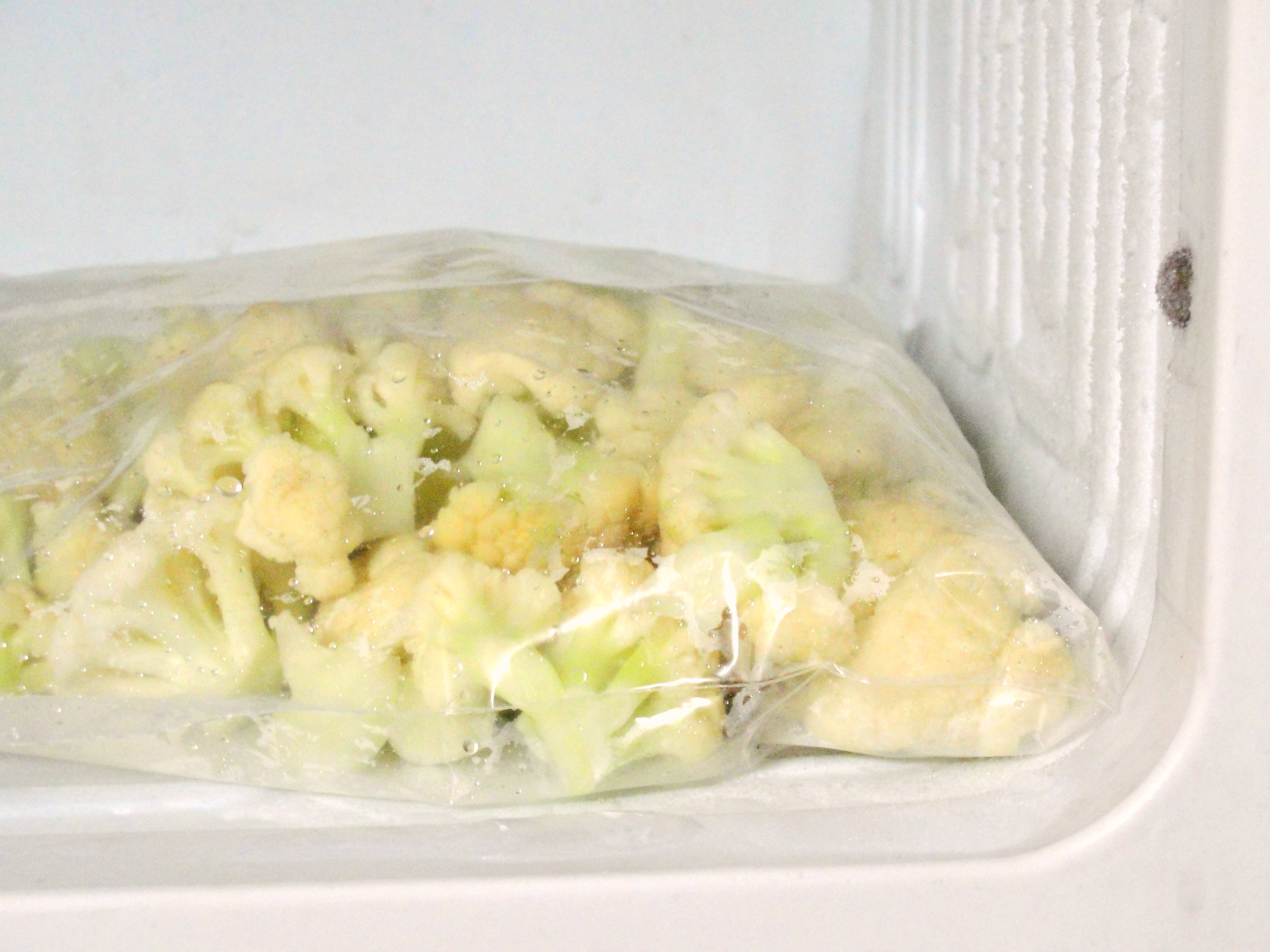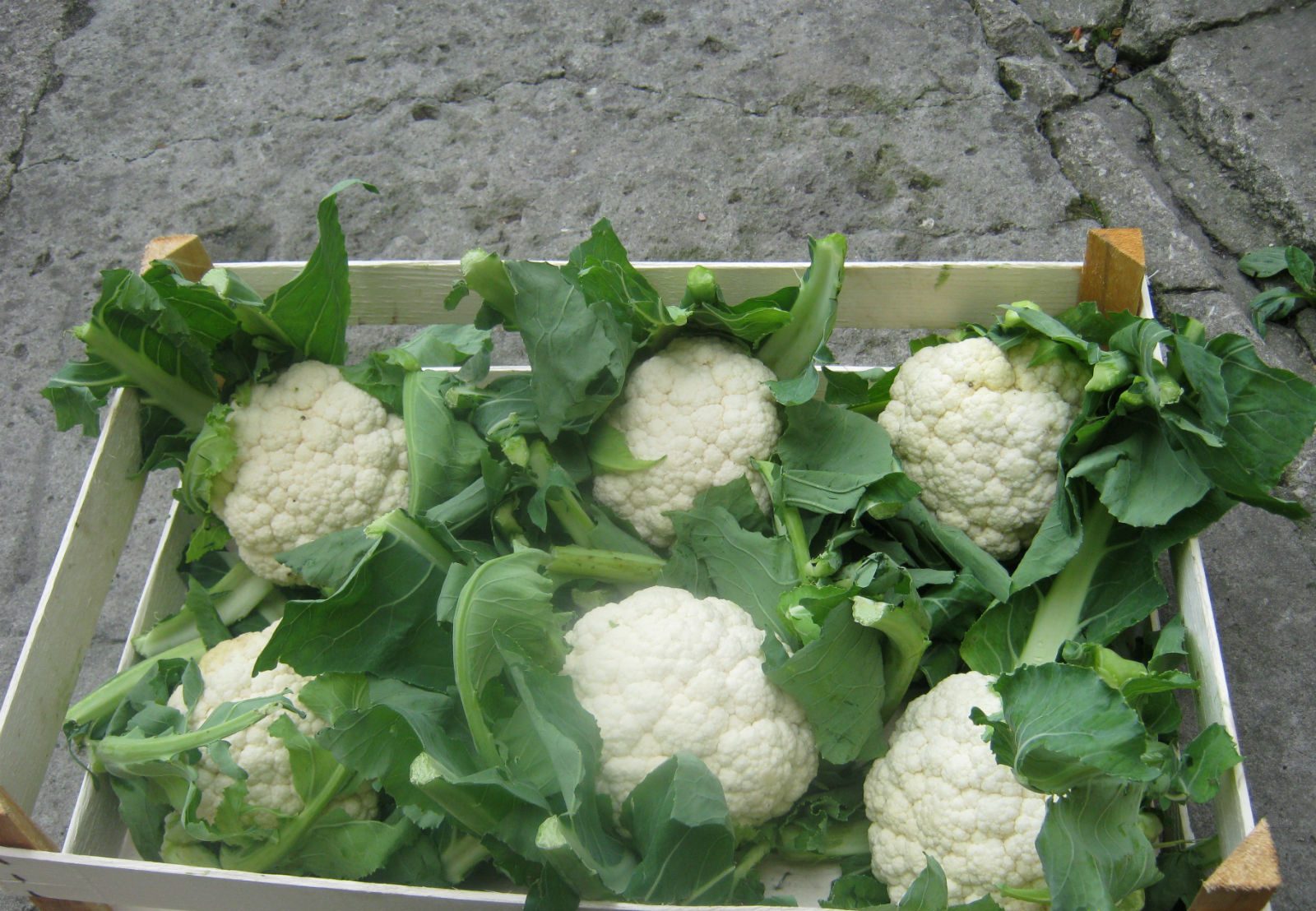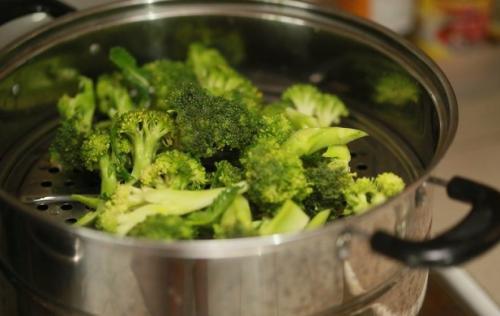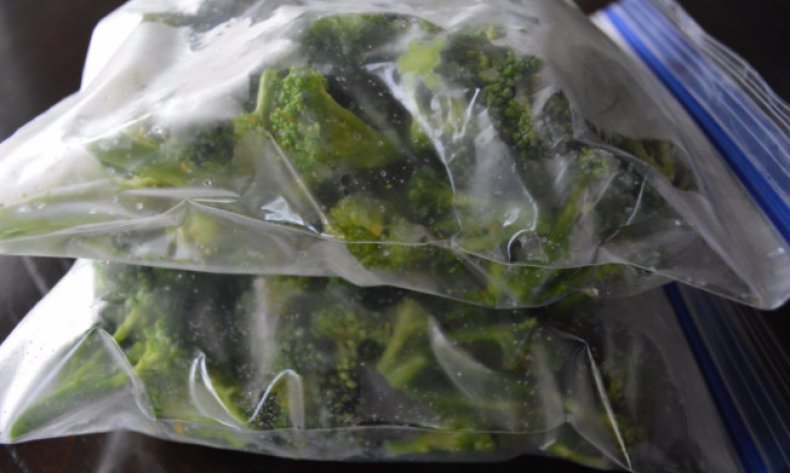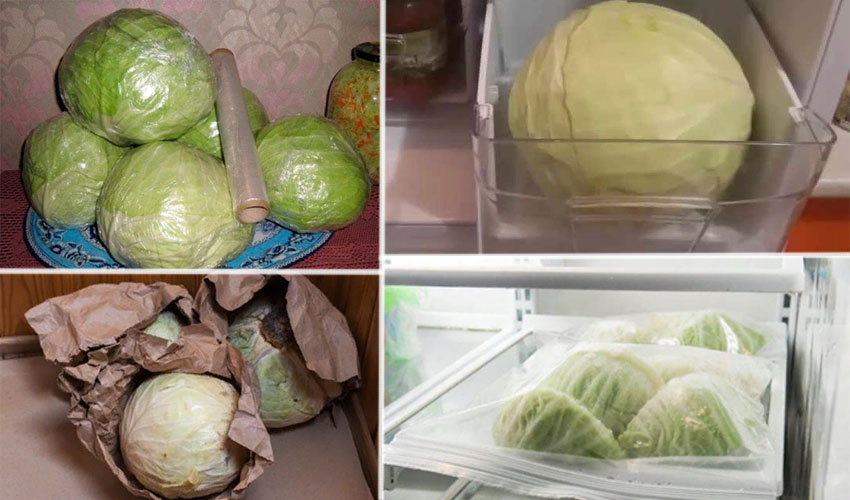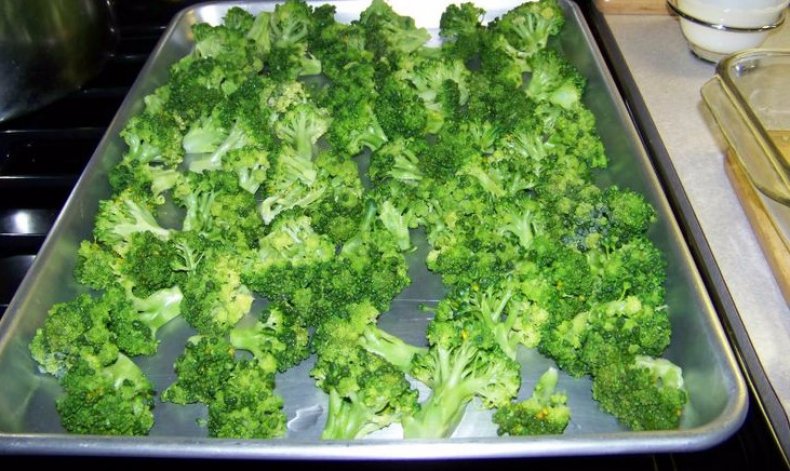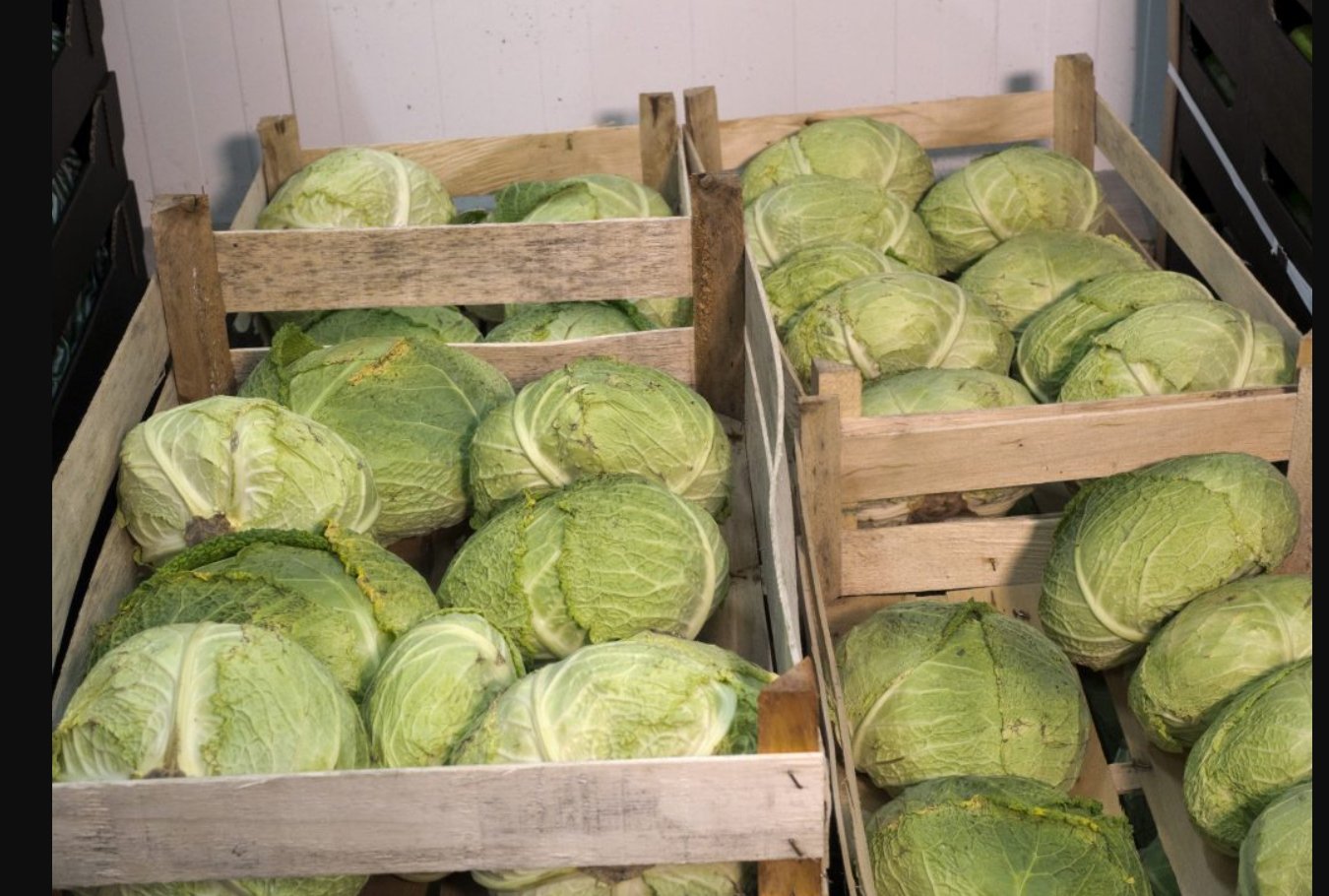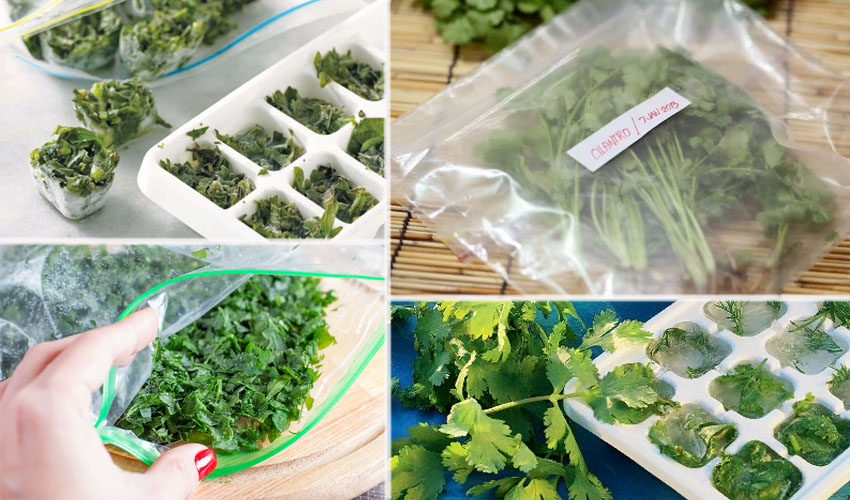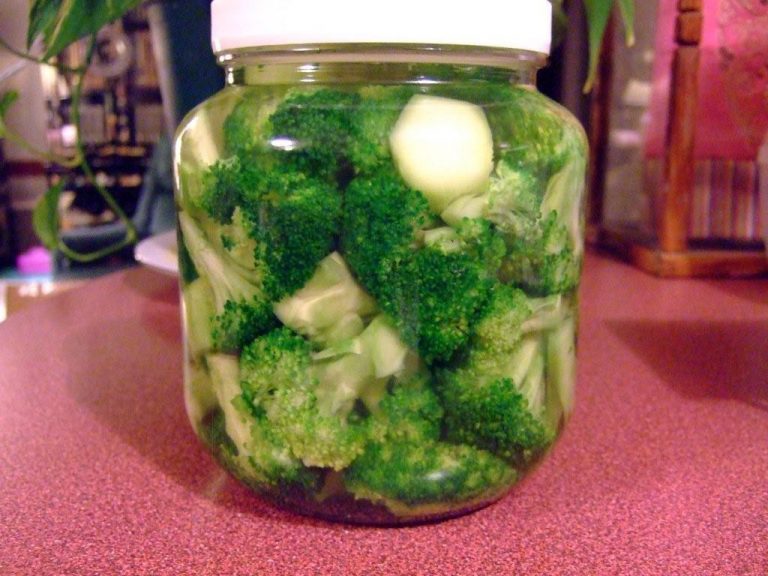Storage preparation
To keep the cabbage in the freezer longer, the heads are pre-washed from dirt. If there are suspicions that pests have started in the plants, the heads of cabbage should be soaked for 30 minutes in a salt solution. After the procedure, they are washed with water, the leaves are removed and, if necessary, cut into inflorescences with a diameter and length of 3 cm. To preserve the color of broccoli, the heads are soaked in cold water with the juice of half a lemon.
The next stage of preparation is blanching. This activity is carried out as follows:
- The washed heads are immersed in boiling water.
- Boil cabbage for 2-3 minutes.
- The inflorescences are instantly thrown into ice water.

You can blanch vegetables in a double boiler. Heads prepared by this method retain more vitamins and nutrients. After the event, the blanks are dried and only then sent to freeze.
If you plan to store it in a refrigerator or cellar, do not wash the cabbage. Therefore, when harvesting, the cleanliness of the forks is monitored. Heads stained with soil or sand are gently cleaned with a soft brush. At the same time, they try not to crush or rub the inflorescences of cabbage, because the slightest mechanical damage reduces the keeping quality of vegetables. You cannot cut off the leaves or shorten the stem from such cabbage, otherwise keeping quality will noticeably decrease.
How to choose broccoli for storage
To maximize the potential of plants, most summer residents prefer early varieties of broccoli, although even they have a ripening period of about 90-100 days. (Late varieties ripen 130-145 days; they can be effectively used only in the southern regions.)
The product is stored exclusively in a cold place (refrigerator or freezer), and the ripening period in this case does not matter.
Broccoli grows quickly in hot weather, so it's important not to skip the ripening period and prevent overgrowth of the heads. The crop should be harvested when the inflorescence does not exceed 15 cm in diameter, while all the buds remain completely closed.
During this period, broccoli takes on a rich dark green color and is most delicious.
If you notice yellowed parts, then some of the buds have already opened. Such a product can be eaten, but it is better to choose unopened inflorescences for storage.
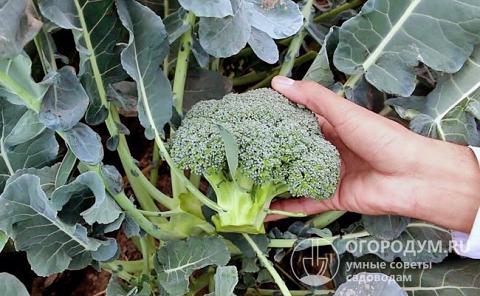 Choose dense dark green heads with a diameter of 5-15 cm for storage
Choose dense dark green heads with a diameter of 5-15 cm for storage
Do not leave the broccoli in the sun immediately after cutting, or it will wither quickly. It is best to harvest in the morning or on a cloudy day. It is also not recommended to cut off the heads immediately after watering or rain: cabbage with an excessive moisture content rots faster. For harvesting, the central head is cut off, leaving a stalk about 10-15 cm long. After 2-3 weeks, new small heads will grow on the lateral stems, which can be eaten or harvested.
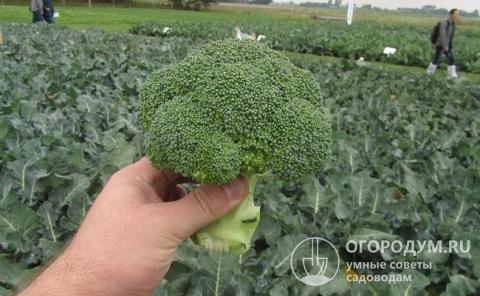 Cabbage should be harvested in dry but not hot weather.
Cabbage should be harvested in dry but not hot weather.
When choosing a vegetable on the market, opt for green cabbage (sometimes it can have a purple hue). Make sure that the heads are tight, without mechanical damage and traces of deterioration. It is better to purchase cabbage for harvesting directly from summer residents, and not from large wholesalers: this way you will have a much better chance of buying a quality product suitable for storage.
How to store broccoli at home?
Storing broccoli in the refrigerator
This type of cabbage has a very short shelf life - 3-5-7 days. Even if you create the most favorable conditions, it will be a maximum of two weeks. The main thing is to properly prepare the heads. So, before store broccoli in refrigerator requires:
- remove ethylene gas from the refrigerator.As you know, ethylene promotes the ripening of fruits, and in this particular case, accelerates the spoilage of broccoli. Record holders for "gas attacks" - pears, apples, apricots, melons, plums, bananas.
- check for defects on the head: mold, brown spots, damage from pests. All this will negatively affect the shelf life of broccoli. Cabbage with blooming buds, that is, with yellowness, is not suitable for storage.
- for short-term storage - and storing broccoli in the refrigerator is just that - a long leg is not needed. It is cut off.
- to provide high air humidity. For broccoli, as for most plant-based products, this is 90-95%. If you are the lucky owner of a modern refrigerator, the so-called. "Zones of freshness", then the question of ensuring such a high level of humidity and a suitable temperature disappears - it is enough to place the vegetable in the zone of "wet freshness". Holders of refrigerators are recommended to put a damp paper napkin at the bottom of the vegetable box, put the head itself in a bag, but do not close it, and put another moistened napkin on top of the bag. You can make it easier - wrap the head with a damp cloth. The temperature for storing broccoli is not lower than zero and not higher than ten degrees.
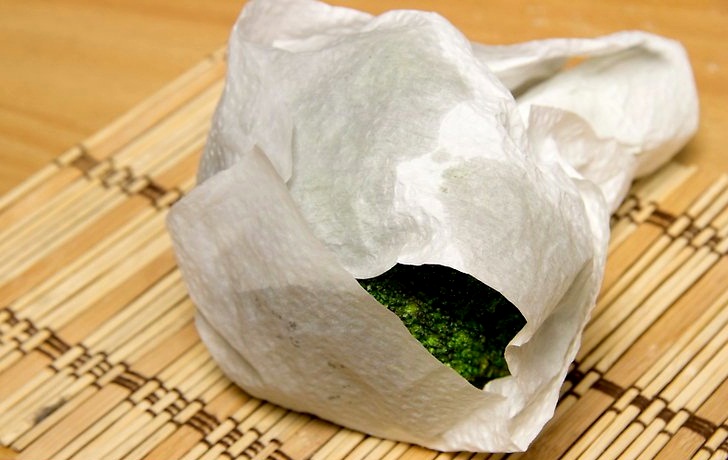
- before bookmark vegetable storage do not wash - this should only be done before cooking.
Storing broccoli in a cellar
This is where the long leg comes in handy, along with the leaves on it. As you know, the lower leaves for cabbage are like a hump for a camel: it is a reservoir of nutrients, and most importantly, moisture. The head, together with the trunk and leaves, are wrapped in paper - each head of cabbage separately, and put on the racks in the cellar. The paper will absorb excess moisture from the air, preventing broccoli from rotting, but it will also "hold" moisture in the broccoli itself, creating a favorable microclimate and preventing the cabbage from drying out. Perhaps broccoli will not last until spring, then you will be able to keep the heads in a suitable form for a couple of months.
How to store broccoli in the freezer?
Frozen broccoli must be prepared before storing. Firstly, in order to preserve the useful and taste properties of this product as much as possible, and secondly, to ensure that you get rid of the smallest insects lurking in the branched inflorescences of cabbage.
The sequence of procedures looks like this:
- the heads are washed, the stem and leaves are cut off, and divided into small inflorescences.
- dissolve 2 tablespoons of salt in 2 liters of cold water and immerse the inflorescences in the solution for half an hour. This measure will help drive out the smallest caterpillars and insects. Then the cabbage is washed under running water.
- blanch with further sharp cooling. So, in a large pot of boiling water, filled with half or a little more, the inflorescences are lowered and kept for 3 minutes. Then, quickly in the prepared cold, and even ice water, the cabbage is lowered for five minutes, thrown into a colander and allowed to drain off the water.
- packed in containers intended for freezing, - bags or containers. In this form, the shelf life of broccoli is twelve months.

You can also immerse a cabbage stalk in water like a flower - this will also prolong its life! This can hardly be considered as one of the ways to store cabbage, because we know that a rosebud placed in water will not remain a bud, but will open. The same will happen with Brussels sprouts - it will begin to turn yellow and bloom. But it is possible that your out-of-the-box thinking will allow you to extract an interesting life hack from such an opportunity.
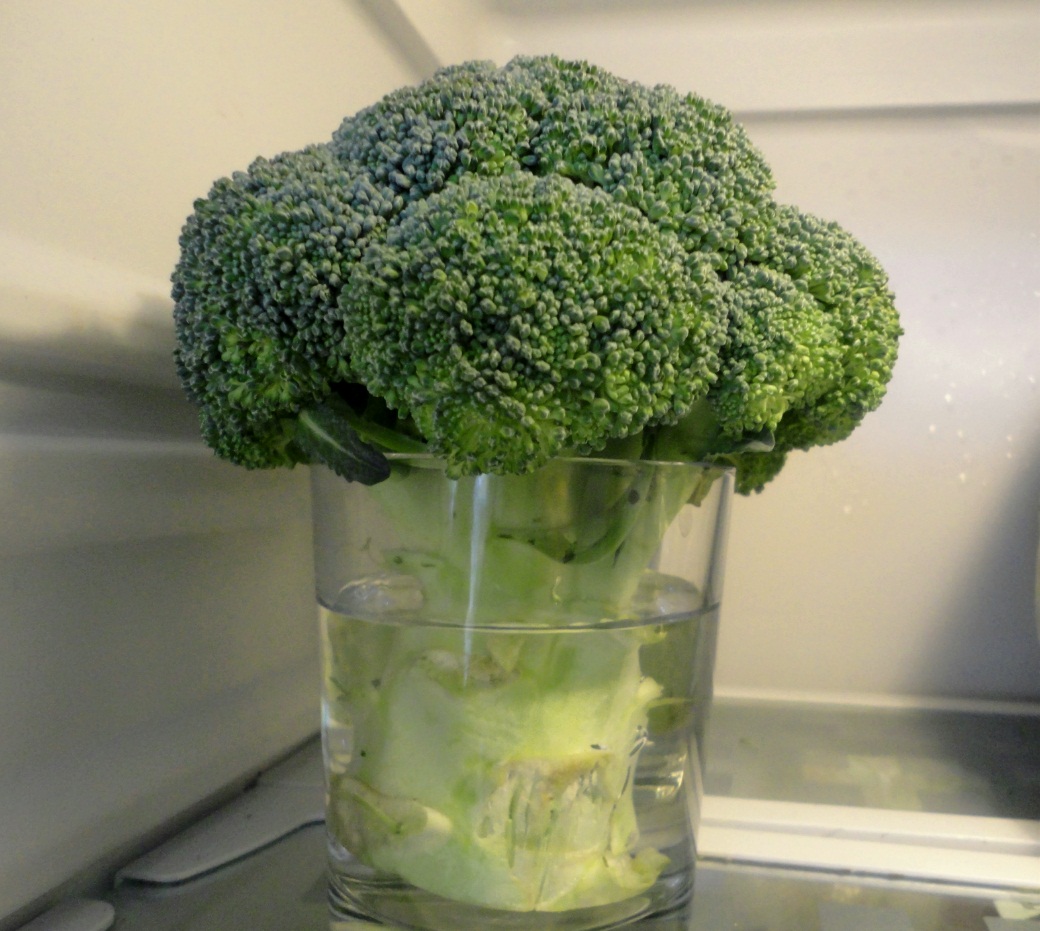
Few vegetables are so strongly associated with a healthy diet today as broccoli. Keeping this vegetable fresh, however, is so short-lived that people often wonder: should we try to keep it in the refrigerator or freeze it? The answer is this: if you do not have a cellar, and the estimated shelf life exceeds 7 days, it is better to freeze the vegetable. It is better than in two weeks to be content with sluggish, yellowish inflorescences that have lost the lion's share of vitamins.
You can read about how to store cauliflower in our next article.
Tatiana Kuzmenko, member of the editorial board Sobcor of the Internet edition “AtmAgro. Agroindustrial Bulletin "
Storage terms and rules
Cabbage is considered a perishable product that, under the influence of various weather and temperature conditions, instantly withers and loses its taste and marketability. However, subject to a low temperature and optimal humidity, broccoli fruits from the garden can be stored for quite a long time. In this case, it is imperative to take into account the characteristics of the variety, as well as know exactly when to harvest the crop, since this directly affects its safety.
Fresh
Since this cabbage withers quickly, keeping it fresh for a long time will not work. Usually, under optimal conditions, cabbage is stored for several weeks, but for this, after harvesting, the crop should be well prepared. The heads are thoroughly washed in cold water, and then trimmed. This best protects vegetables from premature wilting or rotting. Broccoli is stored at a temperature of 0 ... + 5 ° C in a special compartment for vegetables in the refrigerator. Only here is the humidity necessary for long-term storage observed.

Exact adherence to agricultural cultivation techniques will help to extend the season of fresh cabbage consumption more effectively. This provides for gradual harvesting throughout the active growing season. The heads are plucked one at a time, allowing the broccoli to ripen in small portions throughout the season.
Frozen
It is believed that broccoli is practically unsuitable for long-term freezing, but under favorable weather conditions, when the vegetable grows and ripens rather quickly, and it has to be harvested almost every day, the need for long-term freezing becomes simply necessary.
Important! Only late varieties of cabbage are suitable for freezing, since the early ones do not have the necessary shelf life and usually quickly deteriorate even at low temperatures. In this case, you can save the cabbage for 6 months, which makes it possible to use the fruits for cooking only when needed.
The vegetable requires special preparation for freezing, without which it will instantly deteriorate in the freezer.
In this case, you can save the cabbage for 6 months, which makes it possible to use the fruits for cooking only when needed. The vegetable requires special preparation for freezing, without which it will instantly deteriorate in the freezer.
This is done like this:
- Wash the cabbage thoroughly and remove dry parts and stem from it.
- Divide the heads into small florets, and then soak them in 1 tablespoon / 1 L of saline solution for about 30 minutes.
- Rinse the cabbage under running water, and then boil for 3 minutes in boiling water.
- After cooking, dip the hot vegetable in ice water for 5 minutes. Be sure to put a few ice cubes in the liquid.
- Dry the broccoli and then pack it in plastic bags or food containers.
How to store broccoli
To enjoy this cabbage for a long time, it is important to know how to store your broccoli properly. When storing broccoli, remember that the vegetable is very picky and does not tolerate warm conditions, since it needs humid conditions
When storing broccoli, remember that the vegetable is very finicky and does not tolerate warm conditions, since it needs humid conditions.
However, compliance with storage conditions does not guarantee the long-term storage of broccoli. Fresh broccoli can be stored for 7-14 days. For longer storage, it is better to freeze the cabbage.
How to store broccoli in the refrigerator
In order to store broccoli in the refrigerator, you need to know that you should not wash cabbage before storing it, as this can significantly reduce the shelf life of broccoli. It is best to wash vegetables just before eating them.
There are several ways to store broccoli in the refrigerator for a long time.
You can save broccoli for 2-3 days in a paper towel. To do this, you first need to slightly moisten the broccoli with a spray bottle.Wrap the cabbage loosely in paper towels and store in the refrigerator.
You can store broccoli in a plastic bag for up to two days. To do this, several holes must be made in the bags in order to provide air access.
The broccoli can be kept in water for the longest time (up to 5-10 days). To do this, pour a little water (2-3 cm) into the container, put the cabbage in the water with the inflorescence up, cover the container with cling film (making a few holes for ventilation) and store it in the refrigerator on the middle shelf. When storing like this, remember to change the water in the container daily.
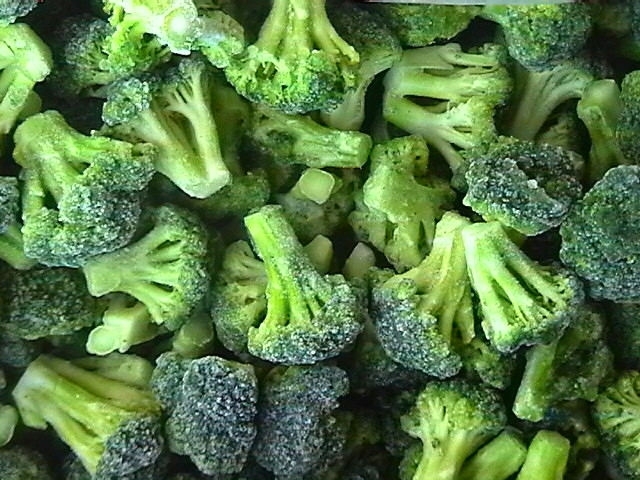
How to store broccoli in the freezer
In order to preserve the broccoli for as long as possible, the cabbage should be frozen.
For storing broccoli in the freezer for a long time, there is a very simple way to preserve broccoli without losing its appearance and benefits when frozen. So:
First, the cabbage must be washed and parasite-ridden. To do this, dissolve two to three teaspoons of salt or vinegar in a container with water and lower vegetables there for 20-25 minutes;
Then rinse the broccoli thoroughly under running cold water and spread on paper towels;
Divide the cabbage into smaller florets;
Boil water and dip broccoli in it for 1-2 minutes;
Add ice cubes to cold water, and then place cabbage there for 3-5 minutes;
Remove and dry the cabbage, then arrange in airtight containers or bags and store in the freezer.
It is best to freeze broccoli in small portions so as not to re-freeze.
You can store broccoli in the freezer for 6-10 months.
How to store broccoli at room temperature
As you already know, broccoli is a rather capricious vegetable that cannot stand warm conditions. Therefore, fresh cabbage must be stored no more than 2-3 hours so that it does not have time to fade and deteriorate. Therefore, cabbage should be eaten immediately or sent to the refrigerator for storage.
Shelf life of broccoli in the refrigerator
7-14 days
Shelf life of broccoli in the freezer
6-10 months
Shelf life of broccoli at room temperature
2-3 hours
Home - Vegetables
- Shelf life of broccoli
Method advantages
There are many advantages to freezing, and the main ones are as follows:
Convenience of storage. Frozen cabbage of this type does not take up much space in the freezer, does not absorb odors and can retain all its nutritional properties for a long time.
Preservation of useful properties. Freezing, unlike other methods of storing food, allows you to almost completely preserve the complex of useful characteristics and the range of taste. If all the manipulations are carried out correctly, following the instructions, the product will hardly differ from the fresh one in taste, color, or vitamin content.
This is especially important for those who plan to cook broccoli for a child, since it is extremely useful to freeze a vegetable for the winter and prepare delicious food from it for children.
The product is always at hand, which significantly saves time. There will be no need to visit the store every time to prepare a healthy breakfast or lunch for the family
Broccoli will always be at home in a form that is completely ready for heat treatment and serving.
Saving money. It's no secret that vegetables in winter are much more expensive than in season. Therefore, by purchasing food during a period when the price for them is low, and freezing them, during the winter, you can use broccoli to prepare full meals without spending the family budget on expensive groceries in the store.
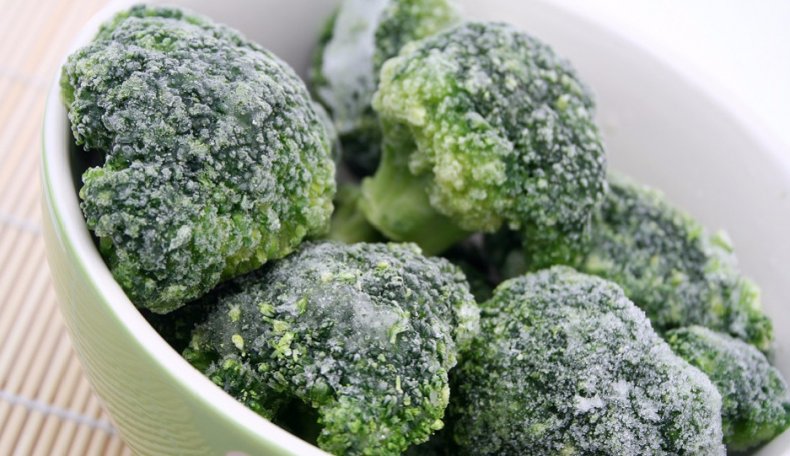
Did you know? Recent research suggests that the broccoli variety of cabbage did not come from natural evolution, but from breeding work. The native land of the vegetable is the northeast of the Mediterranean. At first, such a culture was cultivated in ancient Rome.For a long time outside of Italy, nothing was known about her. Only over time, the vegetable got to Turkey (then Byzantium) and then spread throughout the globe.
In the freezer
Storing broccoli for the winter is possible only in the freezer. Late-ripening dark green vegetables are suitable for long-term storage. The heads should be dense, 10-12 cm in diameter, without yellow spots, with large central inflorescences.
Compliance with the conditions of proper freezing will allow you to preserve a maximum of nutrients and an appetizing appearance of cabbage. Divide the head of cabbage into several pieces. Soak them for 30 minutes in saline (4 tablespoons rock salt in 4 liters of cold water) or vinegar (2-3 teaspoons vinegar in 4 liters of water) solution. This is necessary to drive insects out of the broccoli and wash away any dirt. After soaking, rinse the vegetable under running water and divide into inflorescences, about 3 cm in diameter. Next, the vegetable must be blanched. Fill a deep saucepan 2/3 full with water and put on fire. When the water boils, dip the inflorescences into it so that they are completely in boiling water. After 3 minutes, remove them from the boiling water and immerse them in ice water for 5 minutes. Discard the cabbage in a colander, let the liquid drain well. Dispense inflorescences in bags or plastic containers suitable for use at low temperatures. If possible, pump out the air from the container. Place it in the freezer, turn on the "quick freeze" function. At a temperature of -15 ..- 20˚C broccoli can be stored for up to 6 months.
Freezing is a great way to store all types of cabbage: white cabbage, cauliflower, Beijing cabbage. Now you know how to store broccoli at home, and you can delight your family with dishes with this healthy and tasty product all year round.
How long can cabbage be stored in an apartment?
White cabbage forks, not prepared for long-term storage, that is, not wrapped in a paper bag or not wrapped in cling film, at room temperature can be stored for no more than seven days. Storing cabbage on the balcony, subject to all the above recommendations, will make it possible to eat fresh food until June.
Remember
Coated cabbage can last five months. When frozen, it stays fresh for about 10 months. The preservation of the dried vegetable is one year. In a dry, ventilated pantry, the shelf life of cabbage wrapped in cling film lasts for several months.
The main thing is to preserve cabbage for the winter in an apartment, you need to learn that this is possible with a constant temperature regime from minus 1 degrees to plus 5 degrees Celsius. Humidity at low temperatures can reach 95 percent, at high temperatures - 80 percent. Of course, it is almost impossible to achieve such values (the refrigerator does not count), and therefore it is better not to store white cabbage for a long time.
Other types of cabbage may not stay long in the refrigerator. For example, broccoli, colored, and Beijing broccoli have a shelf life of only a couple of weeks. Kohlrabi, however, a little longer - 30 days.
How to pickle broccoli in the classic way
Here's how to pickle broccoli using a classic recipe as an example. The following ingredients are required for preparation:
- broccoli inflorescences - 400 g;
- carrots - 2 pcs.;
- garlic - 6 cloves;
- fresh dill - a few branches;
- bay leaf - 2 pcs.;
- black peppercorns - 15 pcs.;
- sugar - 10 tbsp. l .;
- salt - 4 tbsp. l .;
- water - 1 l;
- sunflower oil - 200 g;
- vinegar 9% - 1 tbsp.
Cooking a snack is not particularly difficult. If you know how to harvest white cabbage, then you can easily cope with this recipe.
How to pickle broccoli:
- The forks are divided into inflorescences, washed, dried. Carrots are cut into rings or cubes. The garlic is passed through a press. Dill is chopped.
- Vegetables and herbs are mixed in one container, and then put into sterilized jars.
- To prepare the marinade, the water is boiled. Sugar, salt, vegetable oil, bay leaf and pepper are added to it. Cook for 10 minutes, pour in vinegar and remove from the stove.
- The vegetable mixture is poured with hot marinade. Banks are rolled up and left for 2 days in a dark place at room temperature. Then they are stored in the refrigerator.
How to keep broccoli longer
Cabbage cannot stay fresh for long at room temperature, but there are some simple ways to keep your buds firm in the refrigerator.
In fridge
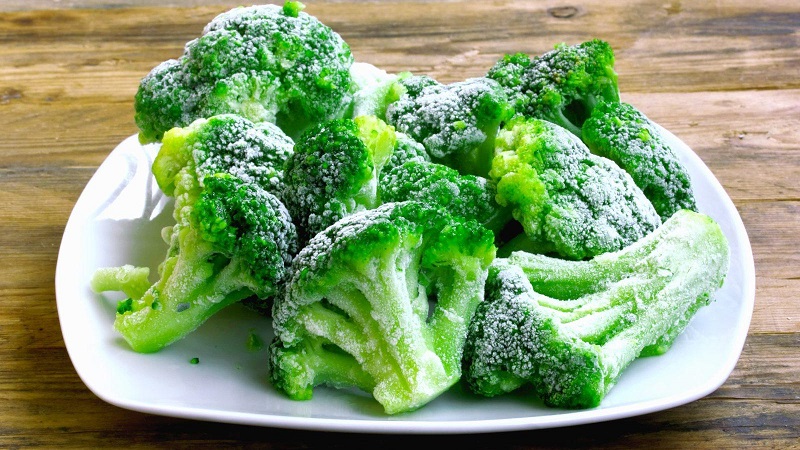
The easiest option is to simply put the cabbage in the vegetable section. The stable low temperature of the chamber will keep the vegetable for 5-7 days.
To preserve cabbage longer, use one of the popular methods.
In a container with water
One of the easiest options is to make an impromptu cabbage bouquet.
Partially in the water, the vegetable will remain fresh for up to 9 days:
- A little water is poured into a container of a suitable size (with a layer of up to 2 cm).
- Broccoli is placed so that the inflorescences are outside.
- The forks are covered with a dense plastic bag, in which several holes are made for ventilation.
In this state, the product is sent to the refrigerator. The water is changed every day.

In a paper towel
The second option involves wrapping the fork in a thick paper napkin or towel. This method is simpler, but the shelf life of the product is no more than 4 days:
Inflorescences are lightly sprayed with water from a spray bottle.
Each fork is wrapped in a paper towel so that it absorbs excess moisture.
It is important that the napkin does not adhere tightly to the inflorescences, otherwise ventilation will be disturbed.
The broccoli wrapped in a napkin is placed in the refrigerator and checked periodically. The first to use are those inflorescences on which signs of deterioration or wilting have appeared.
In a plastic bag
If you want to save broccoli for 3 days, but there is no time for constant control of inflorescences, use this option:
- They take packages of dense cellophane and make several holes in them for ventilation.
- One fork is placed in each bag. The package is tightly tied and sent to the refrigerator.
This method is not suitable for long-term storage, as condensation gradually accumulates in the bag, despite the presence of holes. It also leads to rapid decay of the product.
How to keep broccoli fresh for the winter
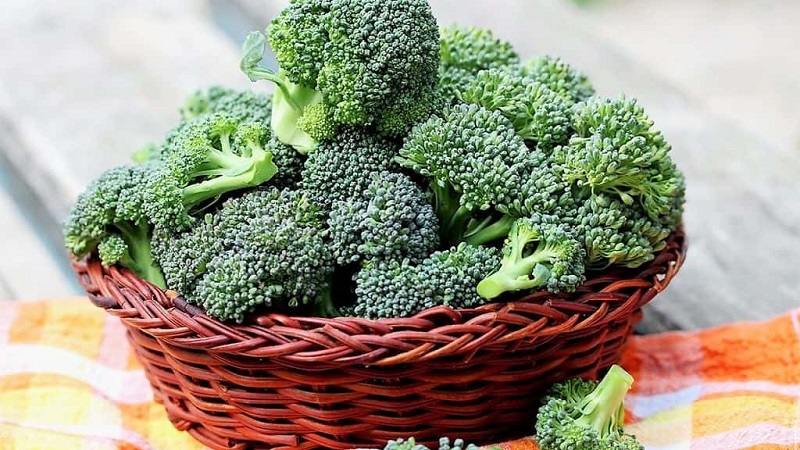
A freezer is suitable for this. The frozen vegetable retains all its taste and useful properties for up to 1 year.
To properly freeze broccoli, follow these instructions:
- The heads are washed, the stems and leaves are removed, and the forks are divided into several parts.
- The pieces are placed in saline solution for 30 minutes and then rinsed under running water.
- Broccoli is placed in boiling water, boiled for 3 minutes and discarded in a colander. When the moisture has drained, the vegetable is immediately placed in a bowl of ice water for 5 minutes.
- The inflorescences are again thrown back in a colander. When excess moisture drains off, dry on a paper or cloth towel.
- Completely dry heads are laid out in one layer on a large plate or tray, placed in the freezer. It is better to turn on the quick freeze mode, if there is one, so that the product grasps instantly.
Frozen cabbage is packaged in portions in bags or containers and sent to the freezer. Do not re-freeze broccoli.
In the cellar
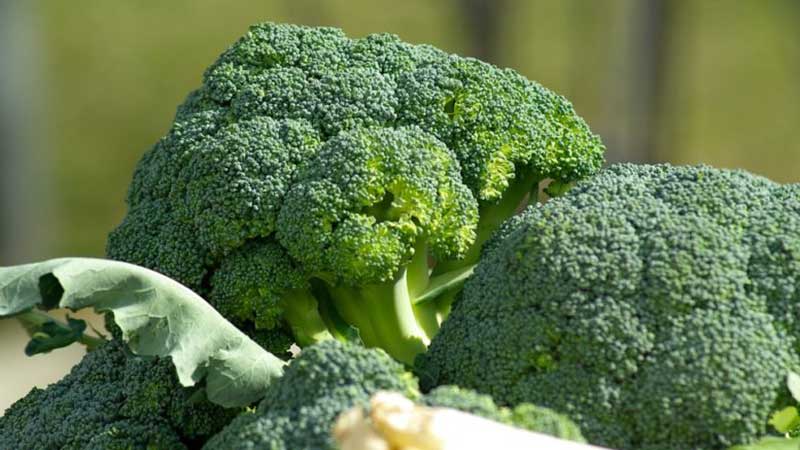
The cool and dry cellar is ideal for storing broccoli for the winter.
To successfully preserve cabbage until a new harvest, follow these rules:
All outer leaves are removed from the heads.
Vegetables are placed in wooden boxes, baskets or simply on shelves
It is important that they have ventilation holes. The bottom must be lined with a cloth.
Forks are laid out so that they do not touch each other.
It is advisable to wrap each head with thick paper and change it as it gets wet.
When stored in the basement, vegetables are periodically inspected and damaged ones are removed, since one rotten specimen will provoke damage to the rest.
How to properly store greens in an apartment
Green leaves dry quickly and turn yellow in the sun. The bundles laid out in several layers rebuke and wither. The best way to preserve greens indoors is to put them in water or wrap them in a damp cloth. In the refrigerator, the freshness of the leaves will keep the temperature in the vegetable compartment.
Parsley and dill
For storage in the cold, the dried bundles are placed in thin cellophane, wrapped in cling film, and placed in plastic boxes. The chopped seasoning is stored in the freezer in plastic.
Shallot
The variety is stored like regular onions in boxes or bags. Unpeeled shallots will last for 7 months. Without husks, it is stored in the refrigerator in plastic containers.
Spinach
The product is usable within 24 hours after collection, regardless of the storage location. Then toxins accumulate in it. Therefore, you cannot find fresh spinach in supermarkets.
Watercress
Cut leaves are negatively affected by heat. The salad variety is placed in plastic containers and placed in the vegetable compartment or on the shelf on the refrigerator door.
Celery
In cellophane, the leaves become soft, so they are wrapped in foil and placed in the cold. Keep fresh in water in room conditions. The roots of the grown celery are stored in boxes with sand, in plastic bags, in an aqueous solution of clay.
Deciduous herbs
Cilantro, tarragon, basil, mint will stand for 2 days in water. In the cold, greens will last 5 days, wrapped in a damp towel.
Arugula
Freshly picked grass will also stand, like a green bouquet, in water. A large number of leaves are packed in zip bags or in a vacuum and stored in the cold for no longer than a week.
Fennel
Stored at + 6 ... + 8 degrees, isolated from other products. A plastic container or wet towel will stop the scent from spreading.
Alternative storage methods
In addition to the above methods, to keep broccoli fresh or frozen, it can also be dried and pickled.
Drying
Drying should be done in a special dryer or oven. This method allows, as in freezing, to preserve the maximum amount of valuable substances in the vegetable. You can dry the cabbage as a whole (if it is medium-sized) or cut into pieces.
The easiest way to dry is in a dryer. Cabbage should be washed, dried and cut, placed in a tray in one layer and set the required time for drying vegetables (6–8 hours) and temperature + 45… + 80 ° С.
Did you know? There is no broccoli that grows in the wild: this cabbage was created through hybridization. It is known that it was cultivated in the 6th-5th centuries BC. NS. in the Mediterranean.
Oven drying technology is as follows:
- Divide the head into inflorescences.
- Wash and soak in saline solution.
- Blanch - place in boiling water for 3-5 minutes.
- Dry for an hour.
- Preheat the oven to + 50 ... + 100 ° С.
- Arrange the cabbage on a baking sheet.
- Place in a preheated oven for 3-5 hours, at regular intervals (once every 30 minutes) checking the readiness of the product and turning it over. The door does not need to be closed completely. If the oven supports convection mode, it must be activated.
Pickling
Broccoli can also be preserved by pickling. The advantages of this method are that the product can be stored for a long time, moreover, it has a piquant taste. By adding various ingredients and spices, you can get a product with a completely different taste, which can later be used as an independent dish or as one of the ingredients, for example, in salads. The disadvantages of this method are the loss of a large amount of valuable substances.


